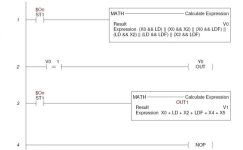g.mccormick
Lifetime Supporting Member
What is the best way to examine multiple inputs at a time for setting an output.
For example lets assume that there is multiple dampers, each damper has an open position indicator. Before the vfd can be requested, N number of the dampers must be opened.
I have done an example in Do-more with 4 inputs and needing any 2 to be on for the output to be on. What about if I need any 2 of 8, or 3 of 16, etc. The ladder logic would get very big very fast. It seems that there should be a way to do this with bitmaps or something.
For example lets assume that there is multiple dampers, each damper has an open position indicator. Before the vfd can be requested, N number of the dampers must be opened.
I have done an example in Do-more with 4 inputs and needing any 2 to be on for the output to be on. What about if I need any 2 of 8, or 3 of 16, etc. The ladder logic would get very big very fast. It seems that there should be a way to do this with bitmaps or something.




